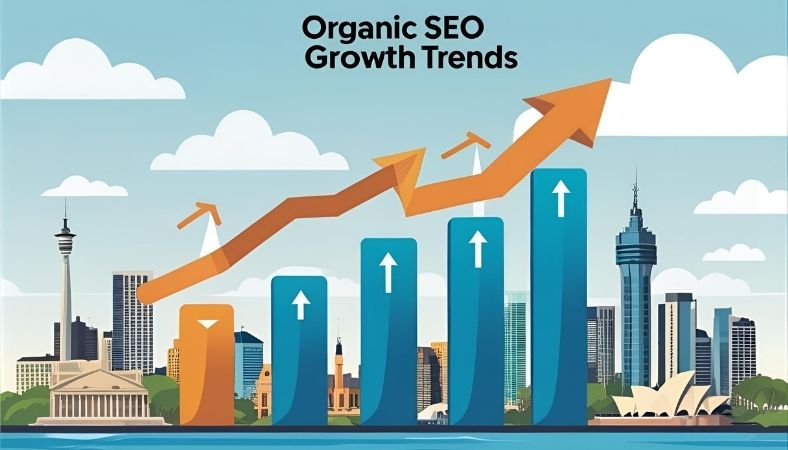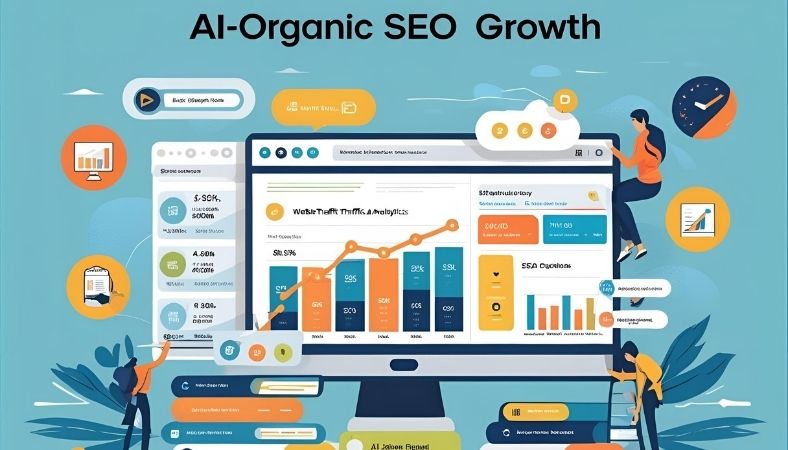How to boost organic traffic in Australia 2025
Your website looks perfect, but the organic traffic is not flowing in. You offer excellent services and have even created some blog posts, but the website’s traffic is not very rewarding. You are managing the best free SEO tools for Australian bloggers.
You are not the only one facing these challenges. In the year 2025, increasing organic traffic from Australia is hitting new levels of difficulty. With the use of AI, tools like Google SGE, and the competition in the market, old SEO strategies won’t work.
Innovative businesses are still growing and actively adapting to how searches are performed today.
Important Parts
- To gain visibility in AI-driven searches, Generative Engine Optimization (GEO) is essential.
- Local SEO, voice search, and People Also Ask (PAA) strategies matter a great deal for businesses in Australia.
- Magnificent boosts in rankings can be achieved using featured snippets, structured data, and honest customer feedback.
- The basics of a solid ranking are a blend of sound technical SEO and top-tier content, not one or the other.
- We have real case studies, tools, and actionable plans to boost visibility for Australian sites.
The Importance of Organic Traffic In 2025
Paid ads have an excellent click-through ratio, but only if you’re willing to pay for them. In contrast, organic traffic brings in visitors to the website for free without any further spending.
What’s New?
In 2025, we will no longer focus solely on keywords. We are focusing on answering questions. Google’s AI now auto-summarizes content, resulting in fewer clicks.
If summaries are not designed around the content, there is a loss of traffic even before the user sets eyes on the website.
Recognizing the Australian SEO Ecosystem
Australia has a distinct digital culture. While understanding SEO on a global level is essential, the local scope is what sets it apart.
Regional Voice Search Trends
Voice search, especially mobile, is flooded with inquiries like “the best plumber near me” and “cafes open now in Melbourne.”
Google Business Profile has visibility as the major make-or-break factor.
Industry SEO Hurdles
- A smaller population leads to a less competitive market and reduced search volumes.
- Building trust is significantly earned via reviews, word of mouth, and reputation; thus, reliability is essential.
- Tradie versus contractor and “heaps good” substituting “very good,” demonstrates the language gaps.
The Change We All Need: Generative Engine Optimization (GEO)
GEO is the future. It means restructuring content to include AI answers.
💡 What to do
Use precise and direct Q&A formats: create FAQs with frequent questions. Answers should be dominant and short (best at 40-60 words).
Focus on straight answers—AI works best with simple frameworks.
In your HTML, remember to include tools like FAQ schema or Q&A blocks.
💭 Example:
Instead of writing:
“Backlinking plays a significant role in your SEO performance.”
Write:
“Backlinks help boost your organic traffic by signaling trust to search engines.”
Optimize for Voice & Conversational Search
“Hey Google, where’s the closest vegan café in Sydney?”
Voice search isn’t just growing—it’s dominating local intent searches.
🎯 Tips to Win Voice Search:
- Ensure to include phrases that are natural and conversational.
- Position subheadings as questions, e.g., “Where can I find ?” to enhance searchability.
- Use the long-tail keywords in your content, but make it more casual.
- Mention local attractions and neighborhoods.
Double Down on Local SEO
When servicing a specific area, local SEO becomes your best friend. It gets your business in front of customers actively looking for your service.
📌 Checklist:
- Business Profile on Google: Set up and enable location-based services.
- Keywords: “Family dentist in Adelaide,” and not just “best dentist.”
- Reviews: Encourage authentic customer reviews on different platforms.
- Location schema: Helps Google know your address and the area of services provided.
💬 Real-World Example:
A landscaping business based in Brisbane optimized their GBP listing and implemented review automation, subsequently ranking first on Google for “landscaper Brisbane northside”. This change effectively doubled inquiries in just 3 months.
Capture Featured Snippets & People Also Ask (PAA)
These are the sections above organic search results and are known as “position zero”. Ranking in these areas would be incredibly advantageous as they receive more clicks than any other position.
🧠 How To Target Them:
- Phrased as bold text beneath H2 headings.
- Lists, steps, or short 40-60 word paragraphs.
- Integrate structured FAQ schema.
- Answer various aspects of the same topic within one article.
🤔 Did You Know?
Google often pulls PAA answers from pages that are well structured with subheadings and definitions.
Build Topical Authority
Focus on increasing your authority on a given topic, rather than just accumulating keywords. Content with more depth, rather than more words, is more favored by Google. Rather than creating a dozen standalone posts, create clusters of content around a singular theme.
- Example: “Home Renovation in Sydney” Strategy
- Pillar page: Sydney home renovations: complete guide
Subpages:
- Bathroom renovation tips
- Kitchen cost calculators
- Permits and council approvals
- Suburb-based case studies
This structure demonstrates topical authority and improves user dwell time on the site, both essential ranking factors.
Use the Right SEO Tools (Without Breaking the Bank)
No two tools are the same. Here is what is currently working in Australia.
🔧 Research Tools:
- SEMrush: Identify keyword gaps and trends.
- Ahrefs: Strong backlink analysis, especially for local outreach.
- Ubersuggest: More budget-friendly option for tracking spend.
🧪 Content Optimization:
- SurferSEO: Helps match the most successful content in terms of style.
- NeuronWriter: Provides GEO-friendly templates.
- Outranking.io: Built for AI snippet targeting.
Case Study: An Aussie Success Story: From 0 to 40K Visits in 6 Months
- Brand: Perth-based digital marketing agency
- Problem: Generic blogs published resulted in no traction with visitors
What They Changed:
- FAQ rewrite of the content
- Voice-optimized blog titles
- Site structure based on topical clusters
Results
- 40K organic visits
- Featured on snippets for 3 major keywords
- 60% decrease in bounce rate
📈 Lesson: Content structure and targeted PAA with schema markup yield impressive results.
7. Mistakes To Avoid They Cost You
You are most likely active on SEO but with the particular practices outlined, your traffic is suffering.
🚫 Mistakes Businesses Make Too Often:
- Ignoring technical SEO: Broken links, slow site, bad mobile user experience, slow mobile UX
- Not refreshing content: Google wants new information more often.
- Using short, too general, keywords.
- Keyword stuffing.
- Image ALT tags, compression not utilized.
Final Thoughts: Your Action Plan for Achieving Measurable Results
Knowing everything isn’t a prerequisite, but it’s crucial to have a strategy for 2025.
Here’s your simplified checklist:
- Use structured content for AI responses (GEO & AEO)
- Use local and voice search keywords
- Update and manage your Google Business Profile
- FAQ blocks with schema markup
- Go for depth of discussion instead of just targeting keywords
- Prioritize fresh content centered on the user
- Use tools wisely avoid shiny-object syndrome
🔁 Try this:
Rewrite the top-performing blog and incorporate structured headings, FAQ schema, and localized keywords. Measure the traffic for 30 days and note the change.
It’s time to stop guessing and start actively working on ranking.
While SEO in Australia has changed, adapting to these changes will put you in prime position to capture organic traffic in 2025.
Frequently Asked Questions
How long does it take to improve organic traffic in Australia?
With consistent optimization of your content and local SEO signals, as well as relevant site speed and SEO modifications, it can take around 3 to 6 months to start noticing trends, depending on the competition in your field and the industry you are in.
What is GEO and how is it different from classical SEO?
While classical SEO works on positioning your site in the search results through the use of links, keywords and on-page optimization, GEO (Generative Engine Optimization) targets getting your content to show up in the responses of AI-generated content submissions.
Which one should I prioritize, mobile or desktop SEO?
Mobile SEO is what you should prioritize, as most Australians browse on mobile. Moreover, Google tends to rank sites that are mobile-friendly. It is wise to have your site perform well on both to have a seamless experience for the user.
What tools can I use if my budget is low?
You can use Ubersuggest, Google Search Console and Rank Math SEO as they are quite affordable. These tools help to track traffic, keyword research as well as edit basic problems at a low cost.




